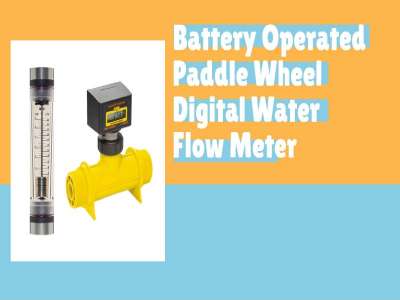Battery Operated Paddle Wheel Digital Water Flow Meter

Flow meters have come a long way when it comes to advancements. These essential flow measurement tools are designed in varying types to measure liquid and gas flow rates in mass or volume. They are built based on their applications in various industries. They also come in different sizes. To operate effectively, they require a power source to run. In recent years, the demand for digital water flow meters has gone up, and manufacturers are working around the clock to satisfy the growing demand.
Digital flow meters are flow meters that display flow rate readings digitally. The main feature of a digital flowmeter is interpreting flow rate measurement in understandable units. In this post, we will look at the digital paddlewheel flowmeters that are uprated using batteries. Read on to gain more insights about battery-powered paddlewheel flow meters.
How do Paddlewheel Flow Meters work?
Unlike other flow meters, a digital water flowmeter is designed uniquely, where flow rate measurements are shown through digital displays. The readings are quite easy to understand, and any person can make sense of them. One peculiar thing about paddlewheel water flow meters is that they measure flow rate outside the pipe.
Paddlewheel flowmeters that run on batteries are great alternatives to operating using electricity if you are looking for portable paddlewheel flow meters. Digital water flow meters that run on batteries use the latest technology. The increasing demand for battery-operated flow meters has led many companies to produce digital flow meters to cater to different applications.
Benefits of Battery-Powered Paddlewheel Flow Meters
The introduction of paddlewheel flow meters that run on batteries brings about many benefits and a few drawbacks. Here are some of the advantages that come with battery-powered digital paddlewheel flow meters.
Easy to Read and Understand
The digital display part of a battery-powered paddlewheel flow meter makes it easy to read the flow rate and make sense. Since the units of measurement are shown digitally on display, users have their calculation part of the measurement cut out for them. Any person in the plant or using a digital paddlewheel flowmeter can measure and understand it. Data in digital paddlewheel flow meters is collected the same way as the manual flow meters. The only difference is that digital glow meters convert measurements for the user.
High Accuracy Levels
Another benefit of using a battery-powered paddlewheel water flow meter is its high accuracy levels when measuring flow rate. Compared to manual flow meters that run on electricity, digital water flow meters are not affected by variables that usually interfere with the accuracy levels. Some of these variables include the velocity of the water and inconsistency indoor upstream.
Unaffected by Pressure and Temperature Change
Paddlewheel flowmeters that operate manually are affected by temperature and pressure change when measuring flow rate. These fluctuations interfere with flow rate accuracy. The good thing about using a digital paddlewheel flow meter that runs on a battery is that it can bypass pressure and temperature.
Electrical Outlet is not Necessary.
Power needs to be supplied to both digital and manual paddlewheel water flow meters for them to function. Most of these flowmeters use electricity to run. This is problematic, especially if the power outlet is not close by. If you use a battery-powered paddlewheel flow meter, then an electrical power outlet won’t be necessary. Since it uses batteries, its power source is within the flow meter.
Portability
The majority of manual paddlewheel flow meters can’t be moved around since they rely on electricity. Digital paddlewheel flow meters that use batteries offer convenience because they are portable and fixed at any piping point. Electric digital paddlewheel water flow meters are usually stationary and can’t be moved around.
Disadvantages
Cost
Among the cons of using the digital paddlewheel flowmeter that uses batteries is the high cost of operation. This is a new technology when it comes to water flow rate measurement. Although it comes with many benefits, you will have to dig deep into your pockets to run and maintain it.
Regular Battery Replacement
Since batteries run out, the user needs to replace them regularly. When the paddlewheel digital water flow meter is used for a long time, the batteries get oxidized and worn out. Compared to flow meters that run on electricity, which don’t require battery change, battery-powered paddlewheel flow meters are rather inconvenient.
Conclusion
Digital water flowmeter technologies keep changing as advancements are made. This is meant to make them perform better and give reliable and easy-to-read flow rate measurements. With the introduction of battery-operated digital paddlewheel flow meters, measuring water flow rate is simple and convenient. However, you’ll have to dig deeper into your pockets if you want to gain from all the benefits it offers.
- Comment
- Posted by Naman Modi